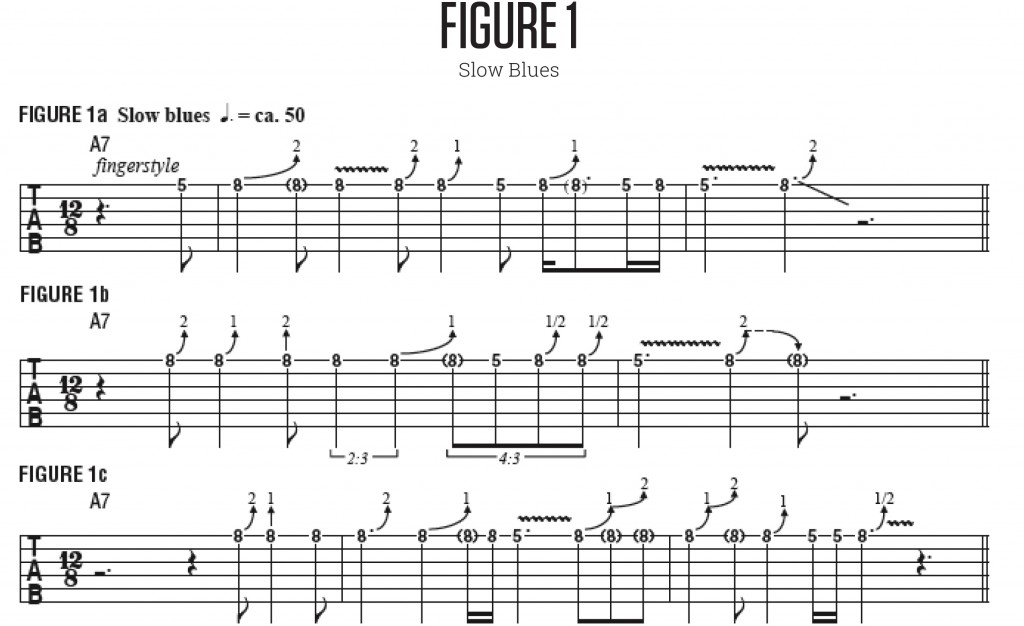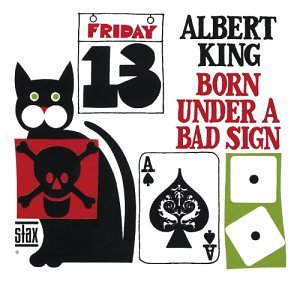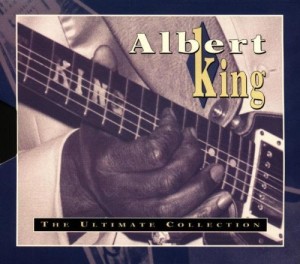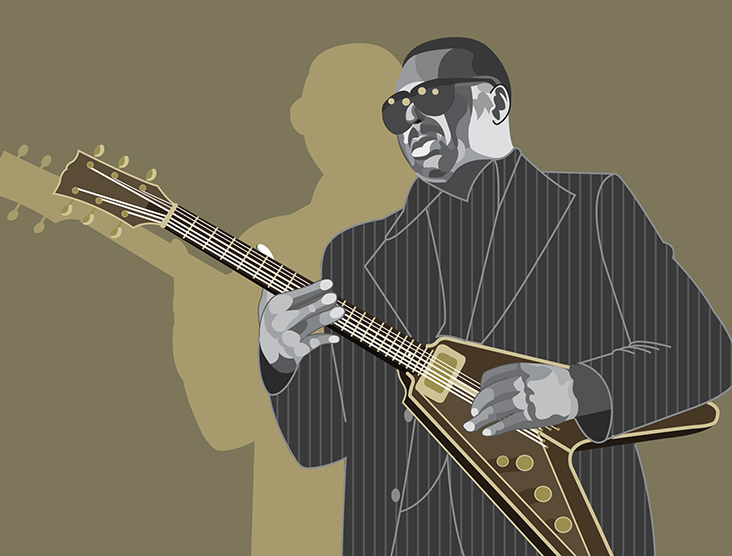One of the greatest and most influential blues guitarists that ever lived is the incomparable Albert King (April 25, 1923 – December 2, 1992), known for his incredible string-bending mastery as well as his signature use of a Gibson Flying V guitar, which he played left-handed and strung upside down and backwards. Albert’s one-of-a-kind soloing style, earmarked by stinging, fingerpicked vocal-like bends and inventive and distinct melodic sensibility, served as a primary influence on the improvisational styles of Eric Clapton, Jeff Beck, Jimi Hendrix, Stevie Ray Vaughan and countless other guitarists. His timeless recordings will certainly continue to inspire guitarists for many generations to come.
Albert learned to play on a guitar strung for a righty—he simply flipped the guitar over and played it in a left-handed manner, resulting in the strings being positioned “upside-down” as compared to the normal stringing of a guitar. In other words, instead of the fattest, lowest-pitched string placed closest to the ceiling, the thinnest highest-pitched string is instead placed closest to the ceiling while the lowest pitched string is positioned closest to the floor. For a right-handed guitar player, the only way to replicate Albert’s stringing (other than to take a guitar strung for a lefty and turning it upside down) is to remove all of the strings and reverse the order, with the high E string strung where the low E string usually goes, followed by the B string, the G string, etc.

Another hugely important element is the fact that Albert tuned his guitar down one and a half steps (low to high: C# F# B E G# C#), facilitating the execution of the great variety of string-bending techniques that comprise so much of his approach to soloing. These different aspects of Albert’s set-up make the replication of his licks very challenging when playing, as most of us do, on a standard tuned guitar that is strung in a conventional manner. So, unless you’d prefer to play upside down and tuned down a step and a half, you will have to take the course charted by Jeff and Eric and Jimi and Stevie (the latter of whom both routinely tuned down one half step), to devise other ways to achieve similar results, all of which are addressed in the following examples.
The great majority of Albert’s licks were played on the top three unwound strings, and oftentimes he’d play a long series of phrases on the highest string alone while remaining “parked” in one position, with the fret-hand index finger fretting the root note for the key he was playing in, and the middle or ring finger used to bend notes fretted higher on the neck. FIGURES 1a-c illustrate three licks played in Albert’s style: in FIGURE 1a, an A root note is played as a pick-up into bar 2, where I begin with a fretted C bent gradually up two whole steps to E; the bend is then released and the note is vibrato-ed, followed by consecutive two- and one-step bends from C. The phrases wraps up by alternating between A and C. For all of the bends, be sure to align the other fingers behind the fretting finger to aid in bending accuracy, as the proper intonation of these bends requires significant fret-hand strength. FIGURES 1b and 1c offer two other phrases played in the identical manner; notice the great variety in the melodic content between each of these licks.
Another essential Albert King technique involves the bending of multiple strings at once, as illustrated in FIGURE 2: on beat one of bars 1, 2 and 3, the high E, B and G strings are all bent at once, fretted with the ring finger positioned at the eighth fret. When bending the high E, catch the other two strings under the tip of the fretting finger. Notice that when the high E string is bent up two whole steps, the B string is bent in the vicinity of a whole step and the G string is bent in the vicinity of a half step.

Another essential technique involves the incorporation of pre-bends, wherein a string is pre-bent a specific amount before it is sounded. In FIGURES 3a and 3b, two-step bends on the high E are followed by one- and one-and-a-half pre-bends on the high E. Albert was a master of microtonal bending, so use your ear and listen closely to insure you have complete control over the notes that are sounded when the string is pre-bent.
These days, most electric guitarists use a standard .010 set (.010, 0.13, .017, .026, .036, .046) but you may want to try a lighter set (.009.5s, .009s or .008s, etc.) to get closer to the slack-string feel Albert attained via tuning down a step and a half.

FURTHER LISTENING
 |
Born Under a Bad SignBorn Under a Bad Sign dates back to a time when albums were collections of singles, and when singles, designed for radio and jukebox play, seldom ran more than three and a half minutes. |
 |
Live Wire/Blues PowerKing signed with Stax in 1966 and soon began winning over young white listeners and released this album the same year. His serrate vocals and homey chats are superfluous. |
 |
Blues at SunsetThis 1973 live album brings together five sides from a 1972 concert at the Los Angeles Memorial Coliseum with four sides from Albert King’s 1973 performance at the Montreux Blues and Jazz Festival. |
 |
Ultimate CollectionThe set consists of a journey through the career of Albert King. With openers such as “Natural Ball” and “Don’t Throw Your Love On Me So Strong” (which actually comes from a Billie Holliday track!) it moves on to the rare Coun-tree sides. |


